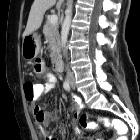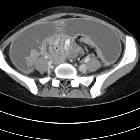malignant peritoneal mesothelioma









Malignant peritoneal mesothelioma is an uncommon primary tumor of the peritoneal lining. It shares epidemiological and pathological features with - but is less common than - its pleural counterpart, which is described in detail in the general article on mesothelioma. Other abdominal subtypes (also discussed separately) include:
Epidemiology
Approximately 20-30% of all mesotheliomas arise from the peritoneal serosal lining. As with pleural mesothelioma, there is also a strong association with asbestos exposure (primarily the crocidolite variety), and this occupational hazard probably accounts for disease predominance in middle-aged to older males (most common age group is 50 to 70 years and it may also account for the slightly increased male predilection).
Despite this, ~50% of cases have no history of exposure to asbestos, although prior radiation exposure, exposure to thorium, talc, erionite or mica, as well as in patients affected by familial Mediterranean fever and diffuse lymphocytic lymphoma have also been reported.
The overall incidence is approximately 1-2 cases per million.
Clinical presentation
Typically patients present with weight loss, anorexia, abdominal pain and/or abdominal distension, pyrexia of unknown origin.
There can be symptoms associated with hypercoagulability particularly due to a paraneoplastic syndrome associated with mesothelioma.
There is a reported correlation between the clinical presentation and CT findings, with subgrouping into :
- dry-painful type: presenting with abdominal pain, CT features of peritoneal mass(es) and little to no ascites
- wet type: presenting with abdominal distension, CT findings of ascites and widespread nodules without a predominant mass
- mixed type: both pain and ascites present
Pathology
As with pleural mesothelioma, three histologic subtypes exist:
- epithelial (most frequent)
- sarcomatoid
- biphasic (mixed epithelial-sarcomatoid)
Radiographic features
Ultrasound
- variable sonographic appearances, from sheet-like hypoechoic to echogenic masses
- omental thickening
- ascites
CT
CT is useful for the detection, characterization, staging, and guiding biopsy of peritoneal masses. Features include:
- solid, heterogeneous, enhancing soft tissue mass
- presence of calcified pleural plaques, indicative of asbestos exposure
- in contrast, peritoneal tumoral calcification is uncommon
- nodular, irregular peritoneal and omental thickening, progressing to omental caking
- peritoneal or omental masses
- variable ascites (mild to moderate)
- direct invasion of abdominal viscera, especially liver and colon.
- concurrent pleural involvement is not uncommon on CT images at diagnosis
Peritoneal mesothelioma does not tend to spread to distant organs and lymphadenopathy is usually not a feature.
MRI
Peritoneal masses and nodules demonstrate :
- T1: low-intermediate signal
- T2: high signal
- C+ (Gd): shows enhancement
Nuclear medicine
- gallium scan: diffuse uptake throughout the peritoneal cavity
Treatment and prognosis
Treatment options include cytoreductive surgery, peritonectomy and intraperitoneal chemotherapy. However, the prognosis is very poor, with death usually within one year .
Differential diagnosis
General considerations include:
- peritoneal carcinomatosis
- most common cause of omental nodules/caking
- more likely to contain dystrophic calcification
- pseudomyxoma peritonei
- lymphoma with peritoneal involvement
- peritoneal involvement with tuberculosis
- mesenteric panniculitis (retractile mesenteritis)
See also
Siehe auch:
- mesenteriale Pannikulitis
- Pseudomyxoma peritonei
- Peritonealkarzinose
- Mesotheliom
- Tuberkulose des Peritoneums
- Tumoren des Peritoneums
- Neoplasien des Mesenteriums
- primäre peritoneale Neoplasien
- peritoneales Lymphom
und weiter:

 Assoziationen und Differentialdiagnosen zu peritoneales Mesotheliom:
Assoziationen und Differentialdiagnosen zu peritoneales Mesotheliom:







